Story at a glance:
- The EU Commission provides financial incentives for green infrastructure and sets policies at the EU level, whereas the US mainly provides policies and incentives at the city or state level.
- EU countries and the US set additional policies and incentives at national and municipality levels.
- Expedited permitting is a successful strategy to support green infrastructure projects.
- Grants, loans, and tax abatements are common EU and US strategies.
Urban green spaces provide a much-needed oasis for our communities, allowing us to relax and rejuvenate. They also create habitats that welcome wildlife back into cities and tackle climate change through carbon dioxide sequestration. In addition, green infrastructure helps cool urban areas during heat waves with natural processes like evapotranspiration, which can significantly lower temperatures.
With the expansion and intensification of urban heat islands, global biodiversity plummeting, and erratic weather patterns leading to droughts and floods, urban green spaces have become essential for urban dwellers. Hence, many governments and institutions have rolled out policies, financial incentives, and programs to support green development. This article aims to give a broad overview of green infrastructure policies in the US and the EU.
Current green infrastructure policies in the EU and US
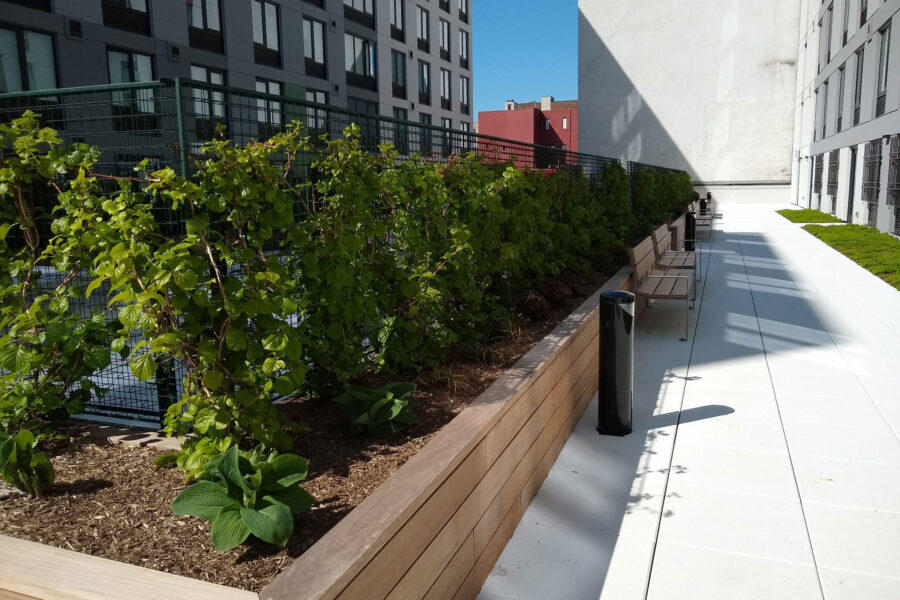
The Wilfrid in the Bronx. Photo courtesy of greenscreen
Both the US and EU are taking steps to prioritize green infrastructure by providing financial incentives to individuals and businesses. While there are differences in how they approach this, we examine good examples from both sides of the Atlantic. Financial incentives are designed to encourage both individuals and businesses to act on addressing environmental challenges. Incentives can range from tax breaks to grants and loans for sustainable projects.
The EU has taken a comprehensive approach by providing directives and funding opportunities like tax abatements, grants, and loan incentives at the EU, national, and local levels. The US regulations and initiatives to promote these technologies are mainly at the state or municipality level.
Despite some issues associated with policies in both regions—like overly bureaucratic paperwork requirements for financial applications and high initial investments that tax incentives may not cover—some excellent programs and initiatives are available.
Here is a closer look at how the US and EU compare when it comes to green infrastructure policies. Let’s start with the US.
Seattle
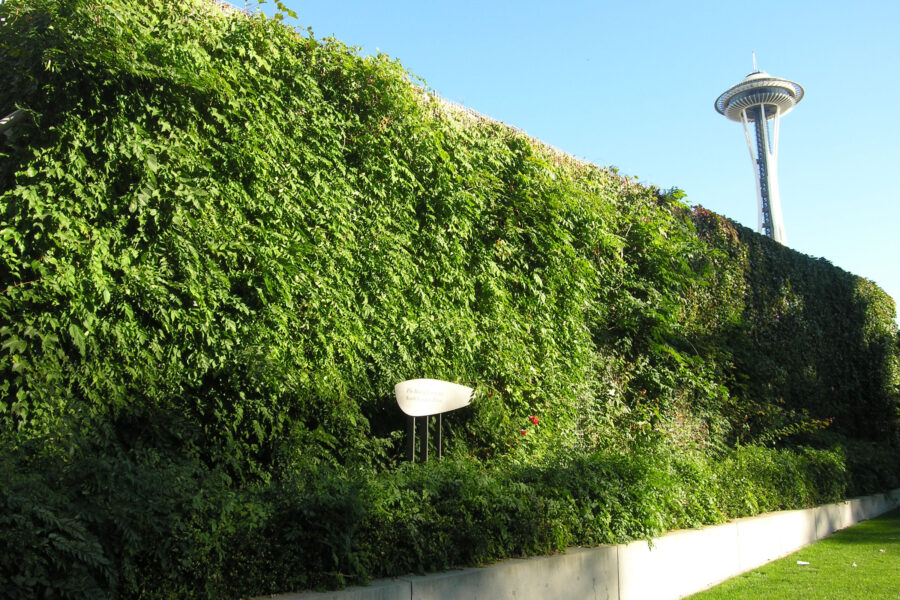
Seattle Center. Photo courtesy of greenscreen
Seattle’s commitment to promoting green infrastructure development has created more than just a sustainable city. By offering tax abatements, expedited permitting, and grant opportunities, Seattle has made it easier for developers to create sustainable projects that benefit the environment and the economy.
The Seattle Green Factor (SGF) and the Green Infrastructure City Policy
Seattle is home to one of the most comprehensive green infrastructure programs in the US. Seattle was the first US city (2006) to adopt a score-based code requirement designed to manage stormwater runoff and improve neighborhood aesthetics.
This strategy was mainly inspired by two European projects—the Berlin Biotope Area Factor (1997) and the Malmö Green Space Factor (2001). The SGF considered those existing models and methods and then adapted and modified them to work within the Seattle context.
Seattle continued developing their green initiatives. In 2013 they created a city policy to reduce combined sewer overflows by implementing green infrastructure like bioretention swales, rain gardens, and green roofs. The city also rolled out a range of financial programs to support green infrastructure across the city—both for small and large projects.
Financial Incentives: Rebates and Expedited Handling
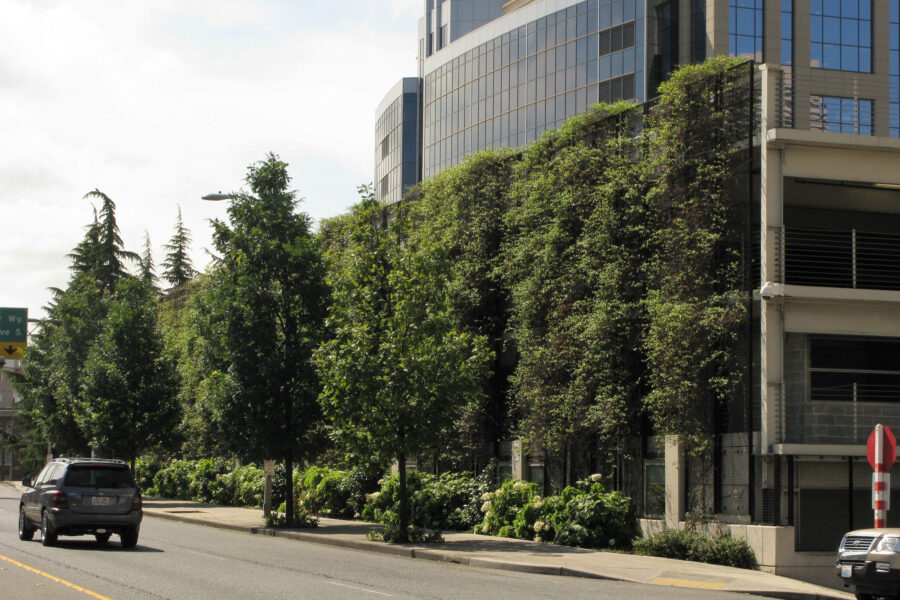
Goat Hill Parking in Seattle. Photo courtesy of greenscreen
Apart from introducing green policies, one of the most significant ways Seattle has encouraged green infrastructure development is through tax abatements and other financial incentives. These incentives encourage businesses and individuals to invest in green infrastructure projects, making them more financially viable and attractive.
The most notable financial incentive available in Seattle is the tax abatement program. This program offers tax breaks for property owners who install green roofs or on-site stormwater management systems. The program provides a 50% exemption on B&O taxes and a 75% exemption on city property taxes for up to 10 years.
Private property owners in eligible combined sewer overflow basins can access a rebate program called RainWise, which covers most or all rain garden installation costs.
The average rebate value is $4,400, making RainWise attractive for smaller regional projects.
Another financial incentive available for green infrastructure development is Seattle’s Priority Green Expedited Permitting Program. This program offers a streamlined permitting process with a reduced fee for green infrastructure development projects, meaning developers can save time and money.
Mini-Grants

Insignia Towers in Seattle. Photo courtesy of greenscreen
Seattle has also made efforts to support smaller projects. For example, King County Wastewater Treatment Division (WTD) offers Green Stormwater Infrastructure Mini-Grants to help eligible landowners invest in green infrastructure solutions. Up to $1,500 is available for most applicants, and those with income limitations may qualify for up to $4,500.
Seattle’s green infrastructure policies have significantly advanced sustainability and environmental protections. The city has recognized the importance of green infrastructure and has implemented several policies aimed at its development. Through these policies Seattle has improved air and water quality, reduced greenhouse gas emissions, and promoted active and sustainable transportation options. Their policies are great examples for other cities looking to promote sustainability and protect the environment.
Chicago
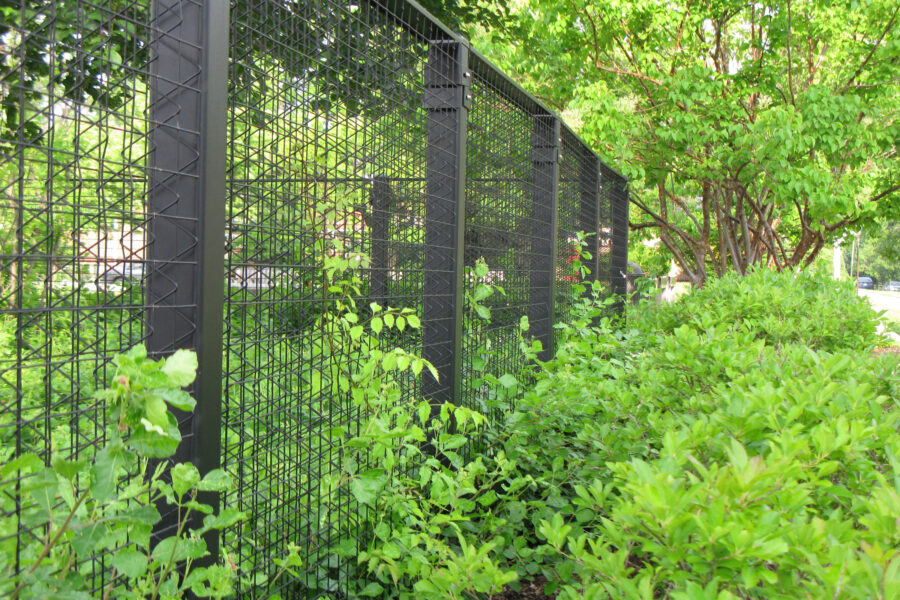
Dunning Branch Library in Chicago. Photo courtesy of greenscreen
Recognizing water is both an essential asset and a potential source of risk, Chicago released its green stormwater infrastructure plan in 2014. This 26-mile lakefront city seeks to utilize green infrastructure to improve the quality of its water resources while simultaneously building climate resilience and reducing flood risks. Accordingly, Chicago has implemented several initiatives to promote the development of green infrastructure projects.
These include incentives like tax credits for businesses that invest in renewable energy sources like solar panels or wind turbines and grants for homeowners who install rooftop gardens or other green roofs. Funding is also available for public parks with native plants, subsidies for urban agriculture projects, support for green job training programs, and more.
Tax Abatements
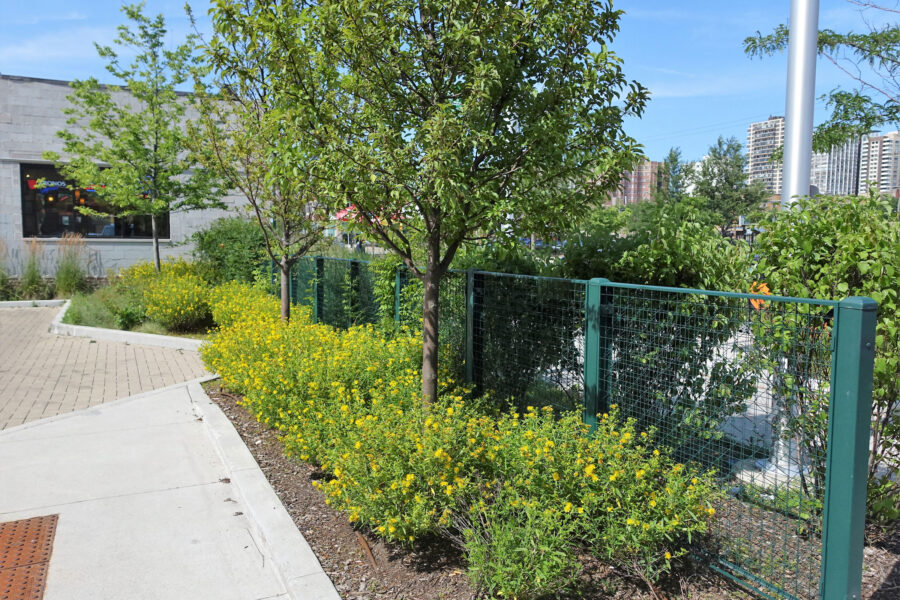
Edgewater Branch Library in Chicago. Photo courtesy of greenscreen
Several tax discounts called abatements are available to businesses and property owners who install green roofing or solar panels in Chicago. For those who install green roofs on their property, a property tax abatement of up to $4.50 per square foot of roof area is available for up to five years and a maximum of $100,000, subject to building conditions. Similarly, property owners who install solar panels can receive a tax abatement of up to $1.50 per watt of installed capacity to a maximum of $100,000.
Grants
Grants are also available through the Chicago Climate Infrastructure Fund, which provides grants ranging from $50,000 to $250,000 for energy efficiency projects and green infrastructure. These measures will help reach Chicago’s goal of reducing greenhouse emissions by 62% within the next 20 years. Proposals from environmental justice communities are prioritized to balance the traditional uneven distribution of green infrastructure projects between high- and low-income areas.
Other Financial Incentives
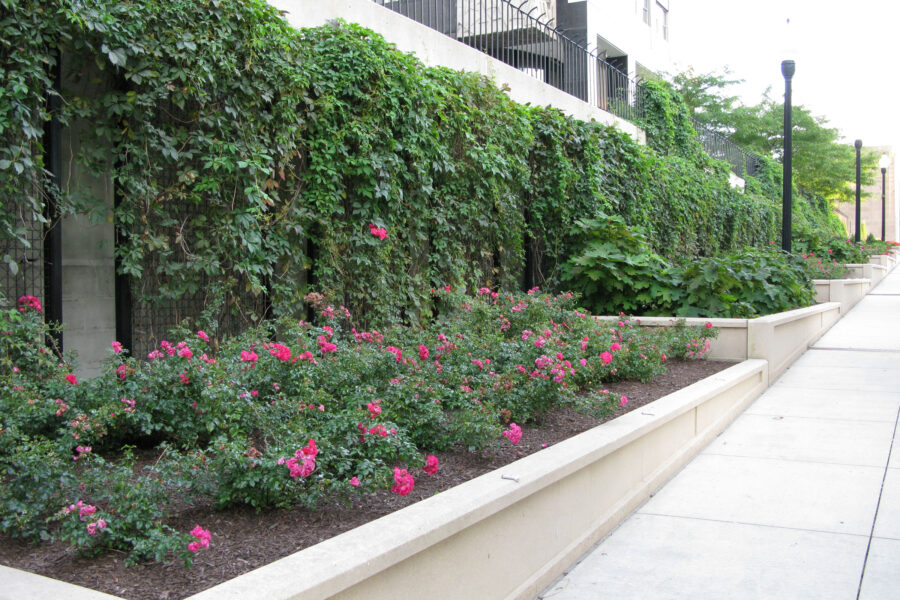
The Park at Lakeshore East in Chicago. Photo courtesy of greenscreen
Chicago has implemented a range of other financial incentives to promote green infrastructure projects, including the Green Permit Program. This initiative provides expedited permit processing and reduced fees for developments incorporating green and sustainable features.
The Green Business Challenge program is another incentive offered to encourage businesses to pursue sustainable projects. Companies that meet specific criteria are eligible for grant funding from the city or other resources depending on their needs. Additionally, the state government may subsidize green initiatives like energy efficiency retrofits and renewable energy projects if they qualify under the Illinois Renewable Portfolio Standard.
Overall Chicago’s green infrastructure policies represent a significant step forward in promoting sustainable development. By offering tax abatements and other financial incentives, the city has made it easier and more attractive for businesses and property owners to adopt green infrastructure initiatives.
New York City
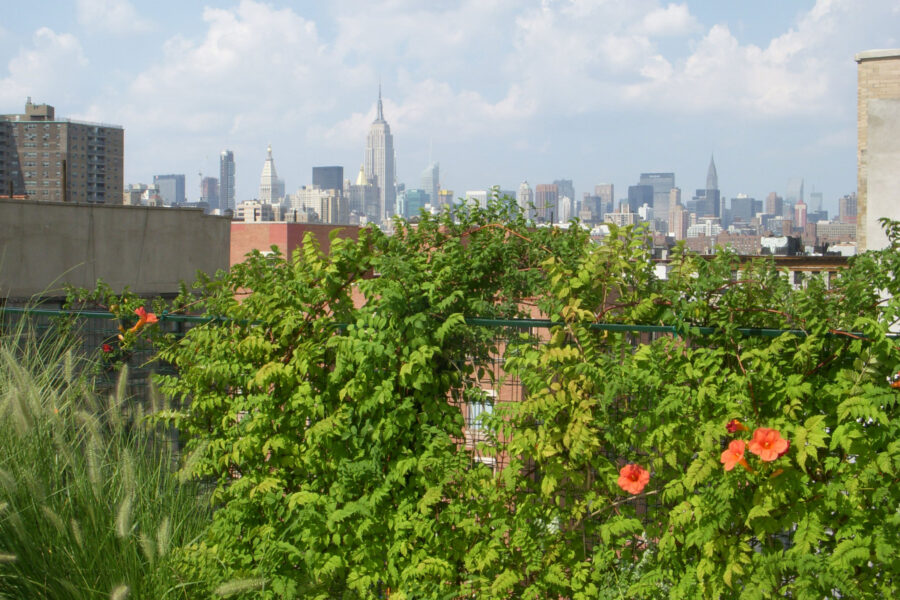
East Village Penthouse in New York City. Photo courtesy of greenscreen
New York City committed to achieving carbon neutrality by 2050—a pledge that led to enacting the most comprehensive initiative for reducing environmental impact in the US called the Local Law 97. The law sets progressive limits on energy efficiency and emission levels for buildings exceeding 25,000 square feet. The city also provides guidance through an established Advisory Board memberships and Climate Working Groups to aid the transition.
The plan aims to implement green infrastructure across 10% of NYC’s impervious surfaces, equivalent to stormwater runoff generated by 1 inch of precipitation per day. This translates to a total coverage area of 8,000 acres by 2030. Currently 1,230 acres have been greened—predominately in public property locations—and close to half of the 8,000 acres are to be installed on private land areas. Support is offered for the installations on private land through incentive programs.
NYC’s Department of Environmental Protection offers several programs encouraging green infrastructure. These programs include the Green Infrastructure Grant program, which grants $10 to 30 per square foot of green roof installed (depending on profile depth). The grant is calculated at half the rate if the green roof is more than 20,000 square feet. The minimum project cost is set to $50,000.
Since 2011 the Grant Program has sought to foster public-private collaboration and engagement concerning green infrastructure projects on private land. Thus far more than $13 million has been awarded by this program to 33 landowners for sustainable construction and maintenance of these infrastructures within combined sewer areas.
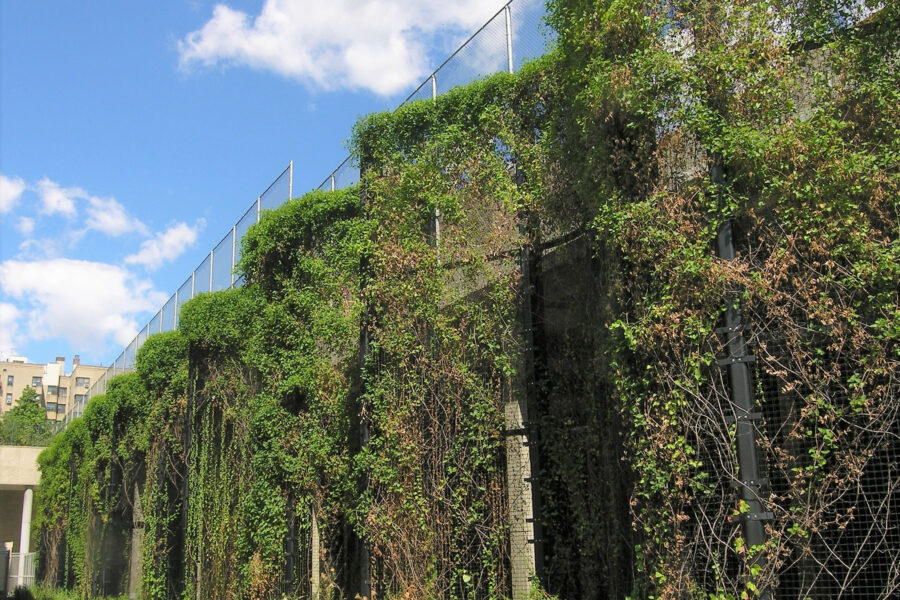
Mott Haven School in the Bronx. Photo courtesy of greenscreen
Properties located in select districts may be eligible for a tax abatement of up to $5.23 per square foot of green roof space, with the benefit capped at the lesser of $200,000 or the dollar value of the property taxes due that year. An enhanced rate of up to $15 per square foot is available if additional criteria are met.
Additionally, NYC’s Green Building Tax Credit program provides tax credits to building owners who use energy-efficient equipment or technologies that reduce energy consumption in their properties.
Overall New York City is leading the way for green infrastructure initiatives, thanks in part to its comprehensive suite of financial incentives designed to encourage sustainable development practices across all five boroughs. The city has made significant progress toward becoming a more resilient and sustainable urban environment through these policy initiatives, which have helped foster a sustainability culture for businesses and residents alike. By continuing to publicize these policies and offer financial incentives, New York City can help to ensure green initiatives become the norm rather than the exception.
EU Cities’ Approach to Green Infrastructure
The EU’s overarching green infrastructure policies are designed to promote the deployment of clean energy sources, reduce emissions, and improve resource efficiency within the union. The main EU financial incentives for green infrastructure projects have stemmed from the European Structural and Investment Funds (ESIF), which was a significant part of the EU budget dedicated to strengthening economic and social cohesion in member states.
ESIF was established in 2014 with an overall budget of €413 billion for seven years ending in 2020. This fund supported businesses through several different incentives, including direct grants and loans, part of which was awarded to green infrastructure projects. The Cohesion Fund has been the other primary source of EU funding for green infrastructure projects, providing a total of €310 billion over the same seven-year period.
To reduce the global threat of climate change and environmental degradation, the European Green Deal has been put into motion with a target to reduce EU-wide Greenhouse Gas (GHG) emissions by 55% by 2030. Furthermore, green investments are considered an EU Covid recovery strategy totaling one-third of the €1.8 trillion from the NextGenerationEU Recovery Plan.
The European Investment Bank (EIB) also supports green infrastructure policies in the EU by providing loans to private companies, public authorities, and non-governmental organizations for investments in clean energy sources like solar panels or wind turbines. EIB loans are typically long-term and have lower interest rates than commercial loans, making them an attractive option for businesses investing in green infrastructure projects.
In addition to the EU-wide funding opportunities, national, local municipalities, and private financial incentives are available from the EU for businesses and public authorities to invest in green infrastructure projects. These programs can help to reduce emissions, improve resource efficiency, and promote sustainable development throughout the EU.
Hamburg, Germany
Hamburg is one of the leading cities in the EU regarding green infrastructure policies. Hamburg was the first major German city to launch a comprehensive green roof strategy. Its goal is to green at least 70% of new buildings and suitable flat or low-sloped roofs. The Hamburg Ministry of Environment, Climate, Energy, and Agriculture supports the project with €3.5 million until 2024. In addition, the city of Hamburg offers incentives for residents and businesses to install green infrastructure, including grants, tax credits, and subsidized loans.
Hamburg Green Roof Fund
The number of subsidies Hamburg offers depends on the type of project. Homeowners and small companies can receive up to €60,000 in grants for energy-saving renovations of their buildings. Medium-sized businesses are eligible for a maximum subsidy of 50% towards the investment costs, while large corporations qualify for 40%. The total amount offered per building is capped at €100,000.
Overall green infrastructure policies have proven to be successful in Hamburg. The city has reduced its emissions by providing financial incentives for businesses and citizens alike while maintaining economic growth. These policies are an excellent example of how cities can simultaneously use green infrastructure initiatives to achieve environmental and financial goals.
Vienna
Climate change dramatically affects the Alpine Region, with the number of hotter days expanding, increasingly severe storms, and urban heat islands becoming more common. Many Austrian municipalities are developing climate adaptation strategies focusing primarily on planting new trees in their cities to address these climate challenges. Green roofs and green wall technologies have also been identified as effective ways of reducing energy consumption while providing protection from heavy stormwater events.
Austria’s green roof and green wall industry is flourishing, having grown at an impressive CAGR of 9% between 2014 and 2018. This growth has been mirrored by the expansion of companies operating within this sector with total sales reaching €90.5 million in 2018 from 1,200 employees working for 550 businesses. Furthermore, 20 research institutes are dedicated to providing scientific knowledge toward innovative solutions for smart cities and urban green infrastructure projects.
The Austrian capital Vienna has taken a proactive approach to green infrastructure. The city offers subsidies for green roofs, green facades, and the installation of solar panels. It also provides support for the renovation of buildings to improve energy efficiency. It should also be noted that Austria’s very effective and knowledgeable green roof association, Grün-Statt-Grau, has played a pivotal role in making Austria greener.
Amsterdam
Amsterdam is another European city that has significantly invested in green infrastructure. The city aims to become carbon neutral by 2050; green infrastructure is a significant part of that effort.
Amsterdam offers subsidies for green roofs, green facades (like the trellis systems from greenscreen), and rainwater harvesting systems.
The city also provides financial incentives for residents who invest in energy-efficient measures, like solar panels and insulation.
In Conclusion

The US Census building in Suitland, Maryland. Photo courtesy of greenscreen
The EU and US provide financial incentives and policies to encourage green infrastructure development in urban areas. While the EU has created high-level directives, funding, and incentives at national and local levels, the US green infrastructure policies are focused at the state or municipal level, like rebates, expedited permitting, and grants and loans.
Recognizing the difference in history and geography between the two regions is important, but learning from good examples and failures is equally important. Paraphrasing astronomer Carl Sagan, ultimately we all live on the same pale blue dot—the only home we have ever known.


